Project Management: Features, Theories and Comparison with Business
VerifiedAdded on 2023/06/15
|16
|4842
|332
Report
AI Summary
This report analyzes the differences between project management and general management, highlighting key aspects and features of project management such as scope management, risk management, and resource planning. It discusses project management theories like Agile and Waterfall, contrasting them with general management theories including Management as Planning, Scientific Management Theory, and Theory X and Y. The report elaborates on two key features of project management: risk identification and resource management, detailing the tools and skills required for their deployment. It concludes by emphasizing the distinct nature of project management in achieving time-bound objectives and ensuring effective resource utilization, contrasting it with the broader organizational focus of general management. This student contributed document is available on Desklib, a platform which provides all the necessary AI based study tools for students.
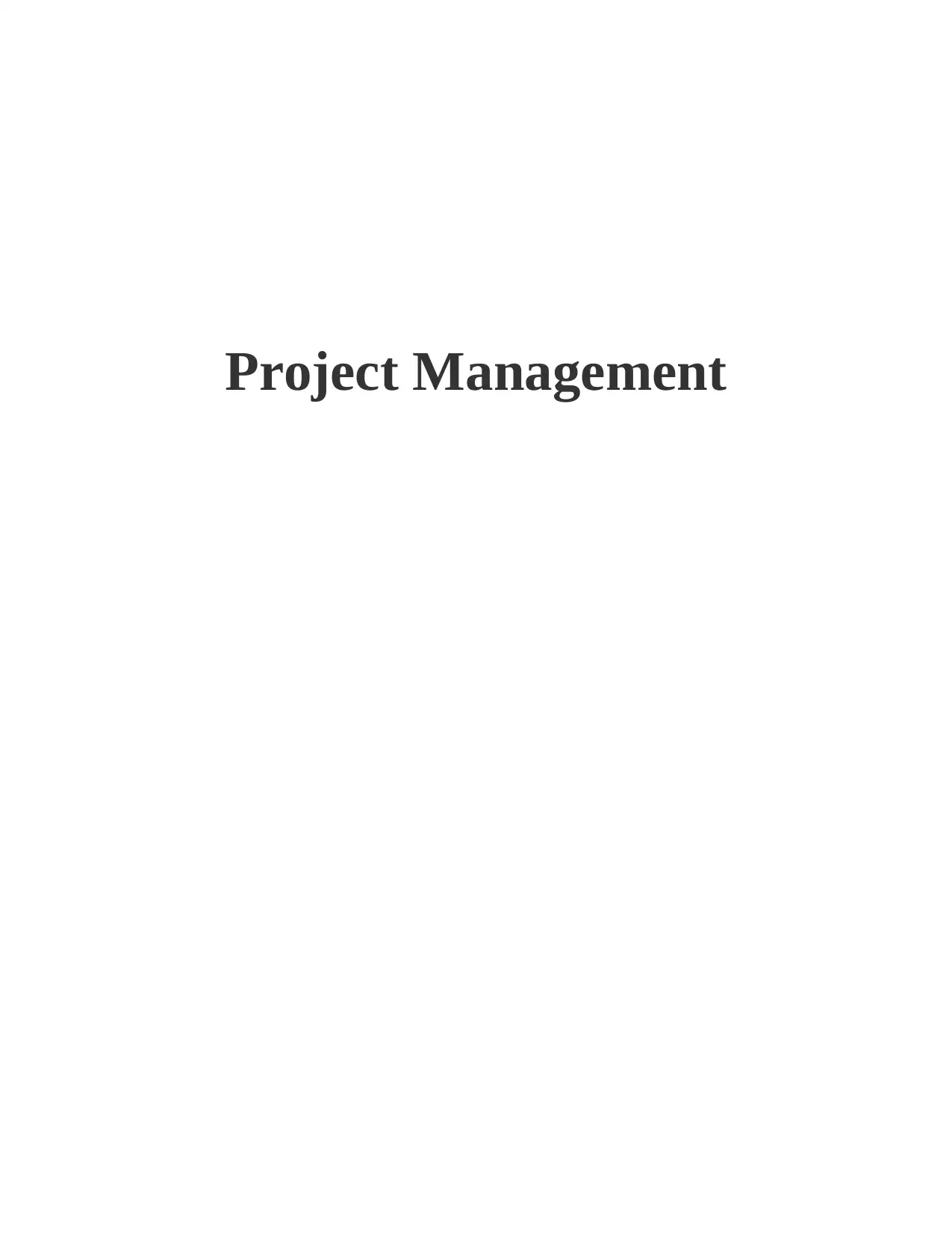
Project Management
Paraphrase This Document
Need a fresh take? Get an instant paraphrase of this document with our AI Paraphraser
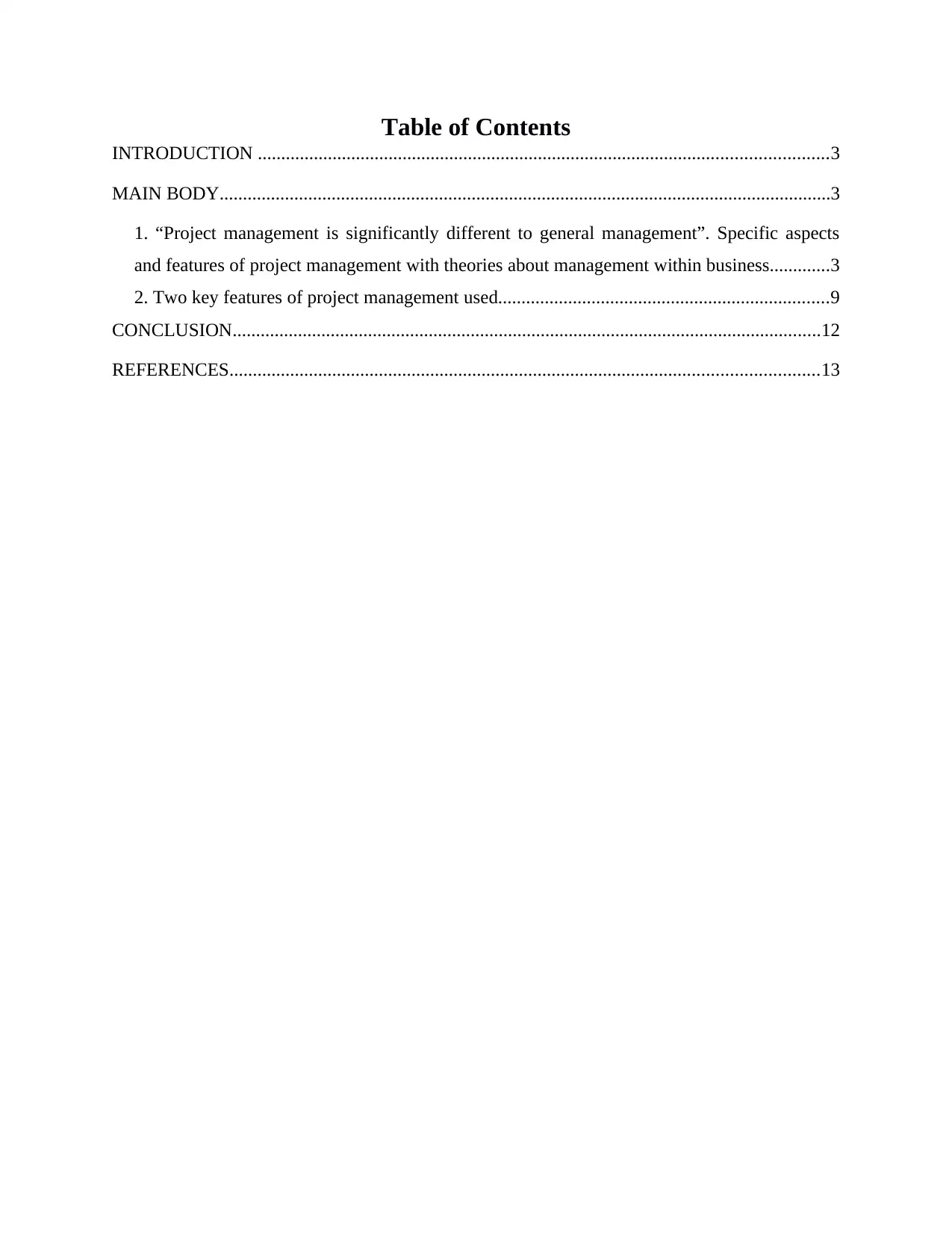
Table of Contents
INTRODUCTION ..........................................................................................................................3
MAIN BODY...................................................................................................................................3
1. “Project management is significantly different to general management”. Specific aspects
and features of project management with theories about management within business.............3
2. Two key features of project management used.......................................................................9
CONCLUSION..............................................................................................................................12
REFERENCES..............................................................................................................................13
INTRODUCTION ..........................................................................................................................3
MAIN BODY...................................................................................................................................3
1. “Project management is significantly different to general management”. Specific aspects
and features of project management with theories about management within business.............3
2. Two key features of project management used.......................................................................9
CONCLUSION..............................................................................................................................12
REFERENCES..............................................................................................................................13
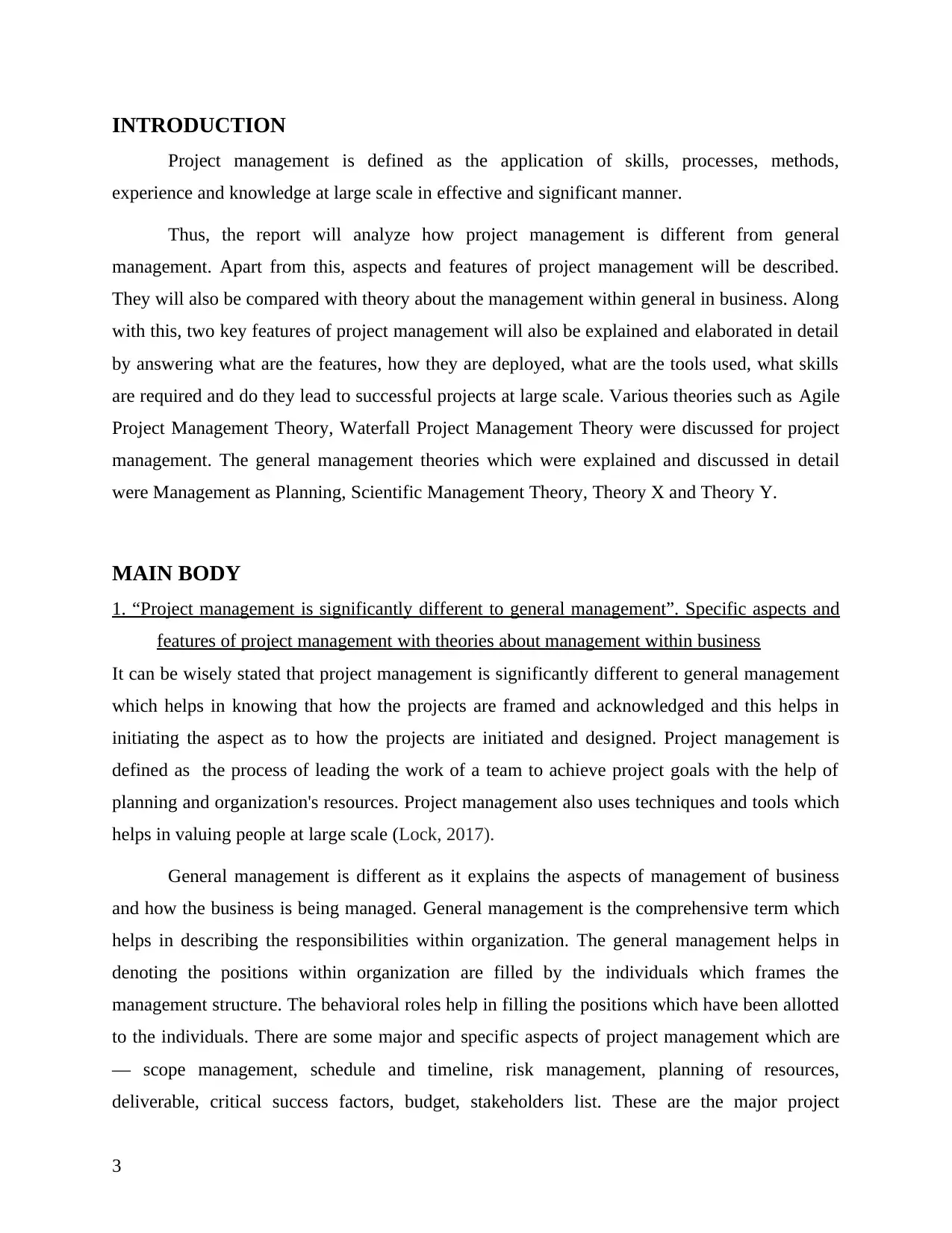
INTRODUCTION
Project management is defined as the application of skills, processes, methods,
experience and knowledge at large scale in effective and significant manner.
Thus, the report will analyze how project management is different from general
management. Apart from this, aspects and features of project management will be described.
They will also be compared with theory about the management within general in business. Along
with this, two key features of project management will also be explained and elaborated in detail
by answering what are the features, how they are deployed, what are the tools used, what skills
are required and do they lead to successful projects at large scale. Various theories such as Agile
Project Management Theory, Waterfall Project Management Theory were discussed for project
management. The general management theories which were explained and discussed in detail
were Management as Planning, Scientific Management Theory, Theory X and Theory Y.
MAIN BODY
1. “Project management is significantly different to general management”. Specific aspects and
features of project management with theories about management within business
It can be wisely stated that project management is significantly different to general management
which helps in knowing that how the projects are framed and acknowledged and this helps in
initiating the aspect as to how the projects are initiated and designed. Project management is
defined as the process of leading the work of a team to achieve project goals with the help of
planning and organization's resources. Project management also uses techniques and tools which
helps in valuing people at large scale (Lock, 2017).
General management is different as it explains the aspects of management of business
and how the business is being managed. General management is the comprehensive term which
helps in describing the responsibilities within organization. The general management helps in
denoting the positions within organization are filled by the individuals which frames the
management structure. The behavioral roles help in filling the positions which have been allotted
to the individuals. There are some major and specific aspects of project management which are
— scope management, schedule and timeline, risk management, planning of resources,
deliverable, critical success factors, budget, stakeholders list. These are the major project
3
Project management is defined as the application of skills, processes, methods,
experience and knowledge at large scale in effective and significant manner.
Thus, the report will analyze how project management is different from general
management. Apart from this, aspects and features of project management will be described.
They will also be compared with theory about the management within general in business. Along
with this, two key features of project management will also be explained and elaborated in detail
by answering what are the features, how they are deployed, what are the tools used, what skills
are required and do they lead to successful projects at large scale. Various theories such as Agile
Project Management Theory, Waterfall Project Management Theory were discussed for project
management. The general management theories which were explained and discussed in detail
were Management as Planning, Scientific Management Theory, Theory X and Theory Y.
MAIN BODY
1. “Project management is significantly different to general management”. Specific aspects and
features of project management with theories about management within business
It can be wisely stated that project management is significantly different to general management
which helps in knowing that how the projects are framed and acknowledged and this helps in
initiating the aspect as to how the projects are initiated and designed. Project management is
defined as the process of leading the work of a team to achieve project goals with the help of
planning and organization's resources. Project management also uses techniques and tools which
helps in valuing people at large scale (Lock, 2017).
General management is different as it explains the aspects of management of business
and how the business is being managed. General management is the comprehensive term which
helps in describing the responsibilities within organization. The general management helps in
denoting the positions within organization are filled by the individuals which frames the
management structure. The behavioral roles help in filling the positions which have been allotted
to the individuals. There are some major and specific aspects of project management which are
— scope management, schedule and timeline, risk management, planning of resources,
deliverable, critical success factors, budget, stakeholders list. These are the major project
3
You're viewing a preview
Unlock full access by subscribing today!
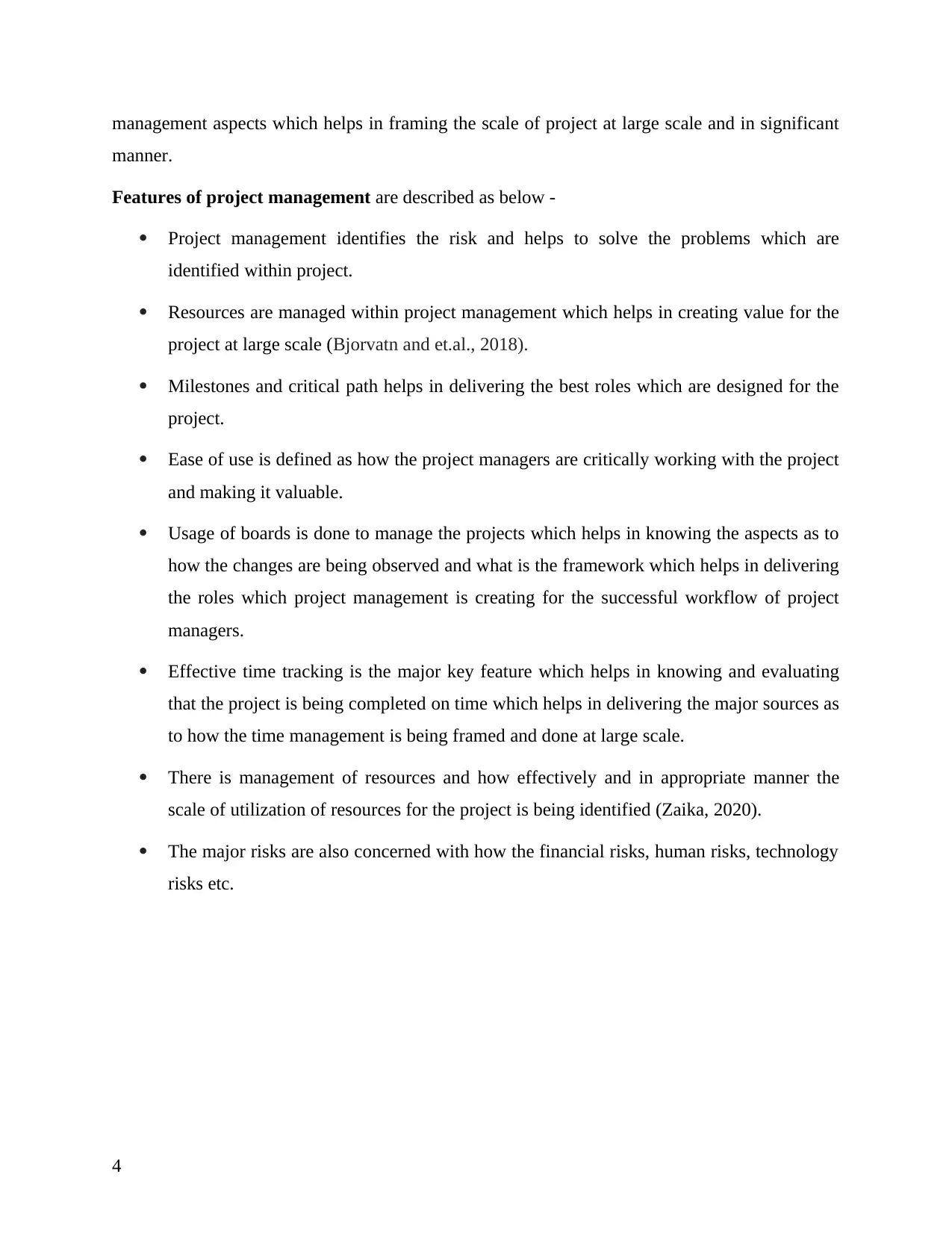
management aspects which helps in framing the scale of project at large scale and in significant
manner.
Features of project management are described as below -
Project management identifies the risk and helps to solve the problems which are
identified within project.
Resources are managed within project management which helps in creating value for the
project at large scale (Bjorvatn and et.al., 2018).
Milestones and critical path helps in delivering the best roles which are designed for the
project.
Ease of use is defined as how the project managers are critically working with the project
and making it valuable.
Usage of boards is done to manage the projects which helps in knowing the aspects as to
how the changes are being observed and what is the framework which helps in delivering
the roles which project management is creating for the successful workflow of project
managers.
Effective time tracking is the major key feature which helps in knowing and evaluating
that the project is being completed on time which helps in delivering the major sources as
to how the time management is being framed and done at large scale.
There is management of resources and how effectively and in appropriate manner the
scale of utilization of resources for the project is being identified (Zaika, 2020).
The major risks are also concerned with how the financial risks, human risks, technology
risks etc.
4
manner.
Features of project management are described as below -
Project management identifies the risk and helps to solve the problems which are
identified within project.
Resources are managed within project management which helps in creating value for the
project at large scale (Bjorvatn and et.al., 2018).
Milestones and critical path helps in delivering the best roles which are designed for the
project.
Ease of use is defined as how the project managers are critically working with the project
and making it valuable.
Usage of boards is done to manage the projects which helps in knowing the aspects as to
how the changes are being observed and what is the framework which helps in delivering
the roles which project management is creating for the successful workflow of project
managers.
Effective time tracking is the major key feature which helps in knowing and evaluating
that the project is being completed on time which helps in delivering the major sources as
to how the time management is being framed and done at large scale.
There is management of resources and how effectively and in appropriate manner the
scale of utilization of resources for the project is being identified (Zaika, 2020).
The major risks are also concerned with how the financial risks, human risks, technology
risks etc.
4
Paraphrase This Document
Need a fresh take? Get an instant paraphrase of this document with our AI Paraphraser
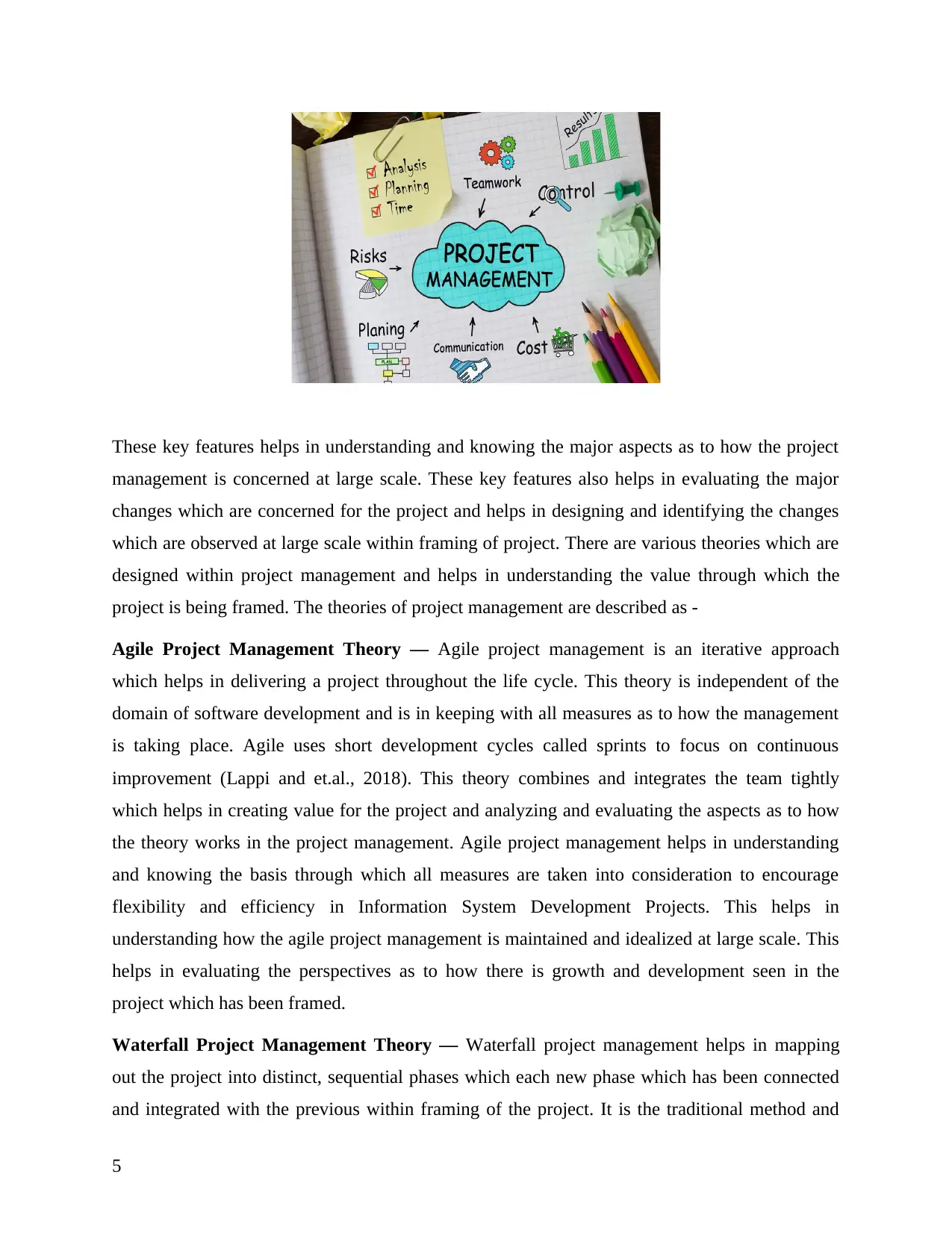
These key features helps in understanding and knowing the major aspects as to how the project
management is concerned at large scale. These key features also helps in evaluating the major
changes which are concerned for the project and helps in designing and identifying the changes
which are observed at large scale within framing of project. There are various theories which are
designed within project management and helps in understanding the value through which the
project is being framed. The theories of project management are described as -
Agile Project Management Theory — Agile project management is an iterative approach
which helps in delivering a project throughout the life cycle. This theory is independent of the
domain of software development and is in keeping with all measures as to how the management
is taking place. Agile uses short development cycles called sprints to focus on continuous
improvement (Lappi and et.al., 2018). This theory combines and integrates the team tightly
which helps in creating value for the project and analyzing and evaluating the aspects as to how
the theory works in the project management. Agile project management helps in understanding
and knowing the basis through which all measures are taken into consideration to encourage
flexibility and efficiency in Information System Development Projects. This helps in
understanding how the agile project management is maintained and idealized at large scale. This
helps in evaluating the perspectives as to how there is growth and development seen in the
project which has been framed.
Waterfall Project Management Theory — Waterfall project management helps in mapping
out the project into distinct, sequential phases which each new phase which has been connected
and integrated with the previous within framing of the project. It is the traditional method and
5
management is concerned at large scale. These key features also helps in evaluating the major
changes which are concerned for the project and helps in designing and identifying the changes
which are observed at large scale within framing of project. There are various theories which are
designed within project management and helps in understanding the value through which the
project is being framed. The theories of project management are described as -
Agile Project Management Theory — Agile project management is an iterative approach
which helps in delivering a project throughout the life cycle. This theory is independent of the
domain of software development and is in keeping with all measures as to how the management
is taking place. Agile uses short development cycles called sprints to focus on continuous
improvement (Lappi and et.al., 2018). This theory combines and integrates the team tightly
which helps in creating value for the project and analyzing and evaluating the aspects as to how
the theory works in the project management. Agile project management helps in understanding
and knowing the basis through which all measures are taken into consideration to encourage
flexibility and efficiency in Information System Development Projects. This helps in
understanding how the agile project management is maintained and idealized at large scale. This
helps in evaluating the perspectives as to how there is growth and development seen in the
project which has been framed.
Waterfall Project Management Theory — Waterfall project management helps in mapping
out the project into distinct, sequential phases which each new phase which has been connected
and integrated with the previous within framing of the project. It is the traditional method and
5
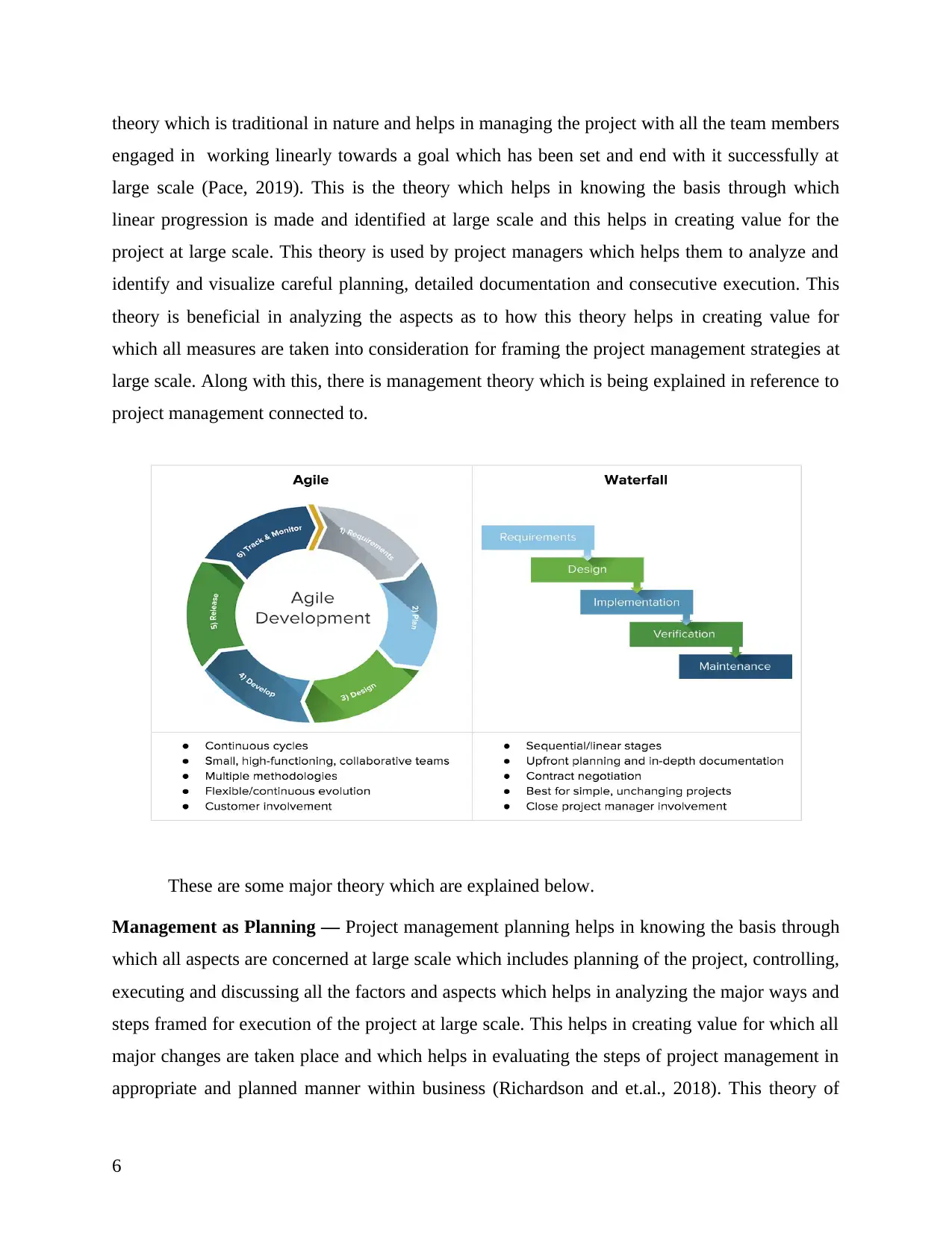
theory which is traditional in nature and helps in managing the project with all the team members
engaged in working linearly towards a goal which has been set and end with it successfully at
large scale (Pace, 2019). This is the theory which helps in knowing the basis through which
linear progression is made and identified at large scale and this helps in creating value for the
project at large scale. This theory is used by project managers which helps them to analyze and
identify and visualize careful planning, detailed documentation and consecutive execution. This
theory is beneficial in analyzing the aspects as to how this theory helps in creating value for
which all measures are taken into consideration for framing the project management strategies at
large scale. Along with this, there is management theory which is being explained in reference to
project management connected to.
These are some major theory which are explained below.
Management as Planning — Project management planning helps in knowing the basis through
which all aspects are concerned at large scale which includes planning of the project, controlling,
executing and discussing all the factors and aspects which helps in analyzing the major ways and
steps framed for execution of the project at large scale. This helps in creating value for which all
major changes are taken place and which helps in evaluating the steps of project management in
appropriate and planned manner within business (Richardson and et.al., 2018). This theory of
6
engaged in working linearly towards a goal which has been set and end with it successfully at
large scale (Pace, 2019). This is the theory which helps in knowing the basis through which
linear progression is made and identified at large scale and this helps in creating value for the
project at large scale. This theory is used by project managers which helps them to analyze and
identify and visualize careful planning, detailed documentation and consecutive execution. This
theory is beneficial in analyzing the aspects as to how this theory helps in creating value for
which all measures are taken into consideration for framing the project management strategies at
large scale. Along with this, there is management theory which is being explained in reference to
project management connected to.
These are some major theory which are explained below.
Management as Planning — Project management planning helps in knowing the basis through
which all aspects are concerned at large scale which includes planning of the project, controlling,
executing and discussing all the factors and aspects which helps in analyzing the major ways and
steps framed for execution of the project at large scale. This helps in creating value for which all
major changes are taken place and which helps in evaluating the steps of project management in
appropriate and planned manner within business (Richardson and et.al., 2018). This theory of
6
You're viewing a preview
Unlock full access by subscribing today!
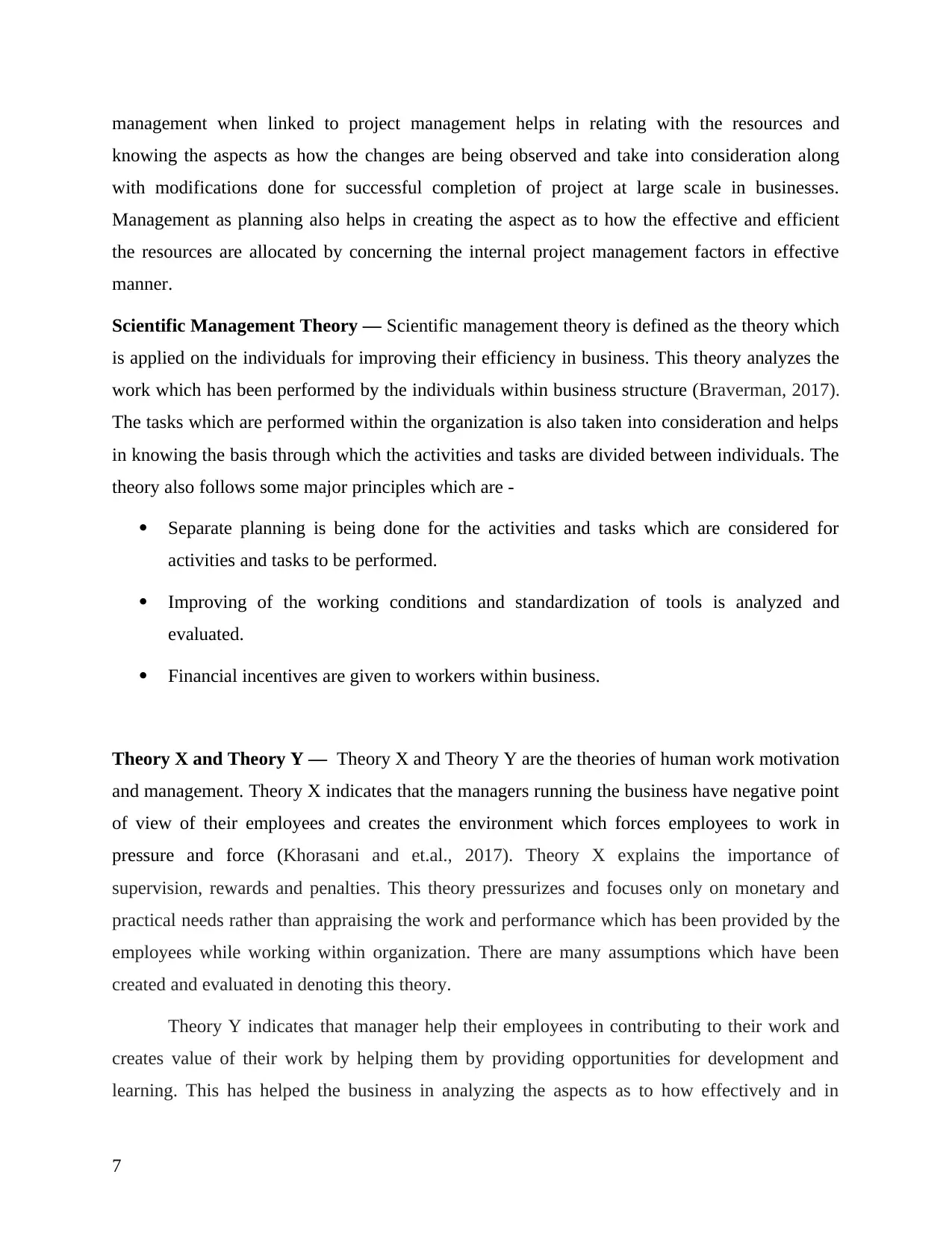
management when linked to project management helps in relating with the resources and
knowing the aspects as how the changes are being observed and take into consideration along
with modifications done for successful completion of project at large scale in businesses.
Management as planning also helps in creating the aspect as to how the effective and efficient
the resources are allocated by concerning the internal project management factors in effective
manner.
Scientific Management Theory — Scientific management theory is defined as the theory which
is applied on the individuals for improving their efficiency in business. This theory analyzes the
work which has been performed by the individuals within business structure (Braverman, 2017).
The tasks which are performed within the organization is also taken into consideration and helps
in knowing the basis through which the activities and tasks are divided between individuals. The
theory also follows some major principles which are -
Separate planning is being done for the activities and tasks which are considered for
activities and tasks to be performed.
Improving of the working conditions and standardization of tools is analyzed and
evaluated.
Financial incentives are given to workers within business.
Theory X and Theory Y — Theory X and Theory Y are the theories of human work motivation
and management. Theory X indicates that the managers running the business have negative point
of view of their employees and creates the environment which forces employees to work in
pressure and force (Khorasani and et.al., 2017). Theory X explains the importance of
supervision, rewards and penalties. This theory pressurizes and focuses only on monetary and
practical needs rather than appraising the work and performance which has been provided by the
employees while working within organization. There are many assumptions which have been
created and evaluated in denoting this theory.
Theory Y indicates that manager help their employees in contributing to their work and
creates value of their work by helping them by providing opportunities for development and
learning. This has helped the business in analyzing the aspects as to how effectively and in
7
knowing the aspects as how the changes are being observed and take into consideration along
with modifications done for successful completion of project at large scale in businesses.
Management as planning also helps in creating the aspect as to how the effective and efficient
the resources are allocated by concerning the internal project management factors in effective
manner.
Scientific Management Theory — Scientific management theory is defined as the theory which
is applied on the individuals for improving their efficiency in business. This theory analyzes the
work which has been performed by the individuals within business structure (Braverman, 2017).
The tasks which are performed within the organization is also taken into consideration and helps
in knowing the basis through which the activities and tasks are divided between individuals. The
theory also follows some major principles which are -
Separate planning is being done for the activities and tasks which are considered for
activities and tasks to be performed.
Improving of the working conditions and standardization of tools is analyzed and
evaluated.
Financial incentives are given to workers within business.
Theory X and Theory Y — Theory X and Theory Y are the theories of human work motivation
and management. Theory X indicates that the managers running the business have negative point
of view of their employees and creates the environment which forces employees to work in
pressure and force (Khorasani and et.al., 2017). Theory X explains the importance of
supervision, rewards and penalties. This theory pressurizes and focuses only on monetary and
practical needs rather than appraising the work and performance which has been provided by the
employees while working within organization. There are many assumptions which have been
created and evaluated in denoting this theory.
Theory Y indicates that manager help their employees in contributing to their work and
creates value of their work by helping them by providing opportunities for development and
learning. This has helped the business in analyzing the aspects as to how effectively and in
7
Paraphrase This Document
Need a fresh take? Get an instant paraphrase of this document with our AI Paraphraser
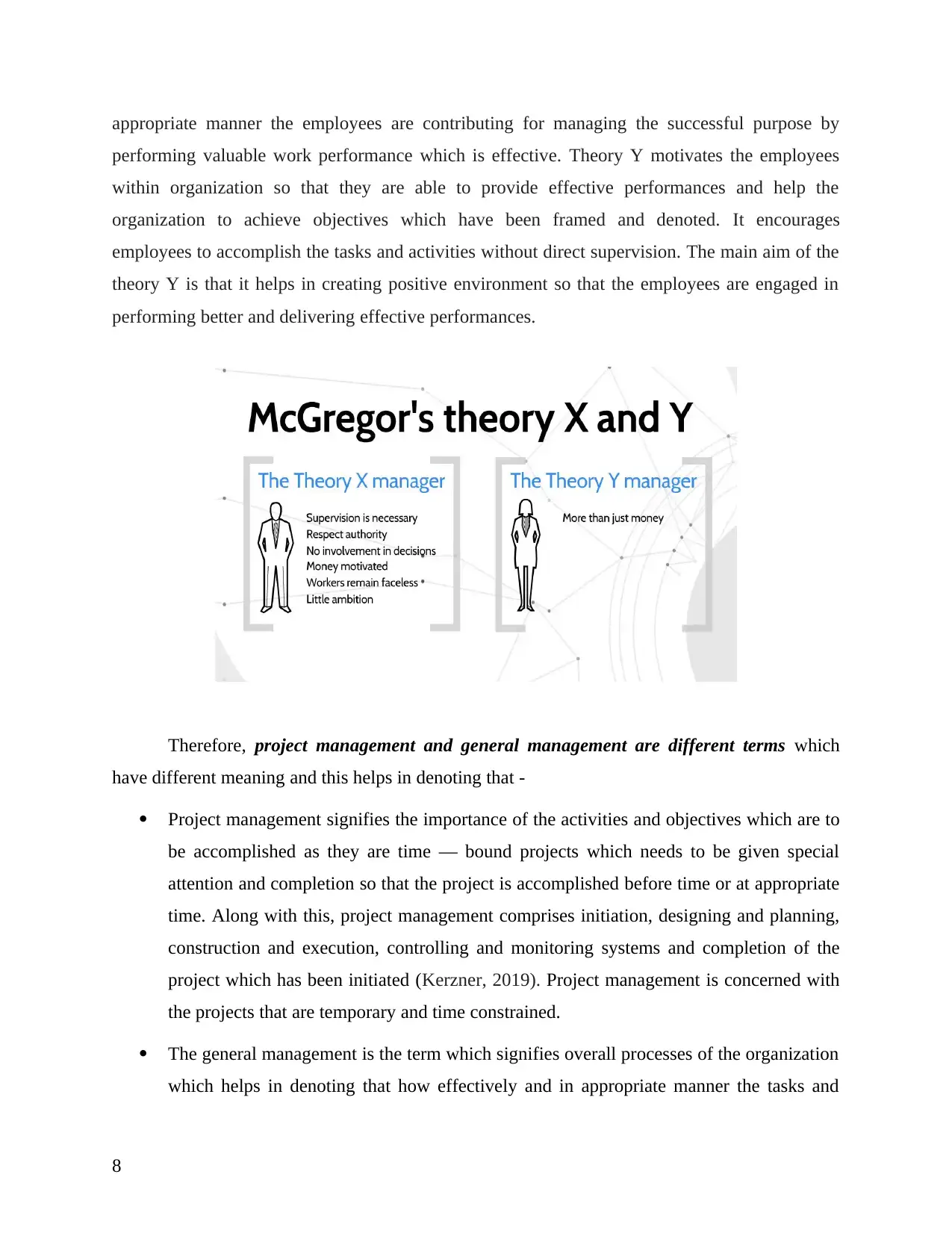
appropriate manner the employees are contributing for managing the successful purpose by
performing valuable work performance which is effective. Theory Y motivates the employees
within organization so that they are able to provide effective performances and help the
organization to achieve objectives which have been framed and denoted. It encourages
employees to accomplish the tasks and activities without direct supervision. The main aim of the
theory Y is that it helps in creating positive environment so that the employees are engaged in
performing better and delivering effective performances.
Therefore, project management and general management are different terms which
have different meaning and this helps in denoting that -
Project management signifies the importance of the activities and objectives which are to
be accomplished as they are time — bound projects which needs to be given special
attention and completion so that the project is accomplished before time or at appropriate
time. Along with this, project management comprises initiation, designing and planning,
construction and execution, controlling and monitoring systems and completion of the
project which has been initiated (Kerzner, 2019). Project management is concerned with
the projects that are temporary and time constrained.
The general management is the term which signifies overall processes of the organization
which helps in denoting that how effectively and in appropriate manner the tasks and
8
performing valuable work performance which is effective. Theory Y motivates the employees
within organization so that they are able to provide effective performances and help the
organization to achieve objectives which have been framed and denoted. It encourages
employees to accomplish the tasks and activities without direct supervision. The main aim of the
theory Y is that it helps in creating positive environment so that the employees are engaged in
performing better and delivering effective performances.
Therefore, project management and general management are different terms which
have different meaning and this helps in denoting that -
Project management signifies the importance of the activities and objectives which are to
be accomplished as they are time — bound projects which needs to be given special
attention and completion so that the project is accomplished before time or at appropriate
time. Along with this, project management comprises initiation, designing and planning,
construction and execution, controlling and monitoring systems and completion of the
project which has been initiated (Kerzner, 2019). Project management is concerned with
the projects that are temporary and time constrained.
The general management is the term which signifies overall processes of the organization
which helps in denoting that how effectively and in appropriate manner the tasks and
8
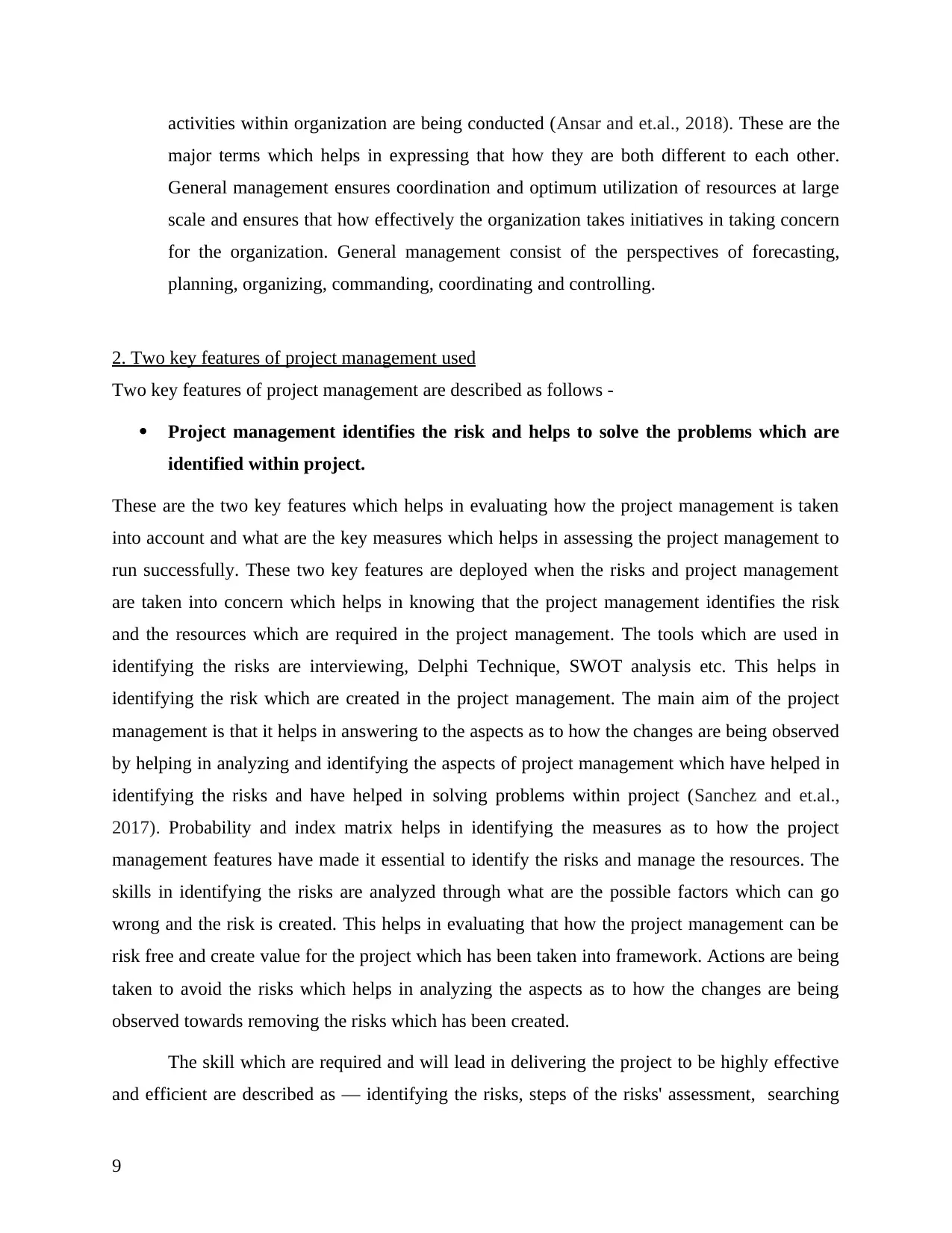
activities within organization are being conducted (Ansar and et.al., 2018). These are the
major terms which helps in expressing that how they are both different to each other.
General management ensures coordination and optimum utilization of resources at large
scale and ensures that how effectively the organization takes initiatives in taking concern
for the organization. General management consist of the perspectives of forecasting,
planning, organizing, commanding, coordinating and controlling.
2. Two key features of project management used
Two key features of project management are described as follows -
Project management identifies the risk and helps to solve the problems which are
identified within project.
These are the two key features which helps in evaluating how the project management is taken
into account and what are the key measures which helps in assessing the project management to
run successfully. These two key features are deployed when the risks and project management
are taken into concern which helps in knowing that the project management identifies the risk
and the resources which are required in the project management. The tools which are used in
identifying the risks are interviewing, Delphi Technique, SWOT analysis etc. This helps in
identifying the risk which are created in the project management. The main aim of the project
management is that it helps in answering to the aspects as to how the changes are being observed
by helping in analyzing and identifying the aspects of project management which have helped in
identifying the risks and have helped in solving problems within project (Sanchez and et.al.,
2017). Probability and index matrix helps in identifying the measures as to how the project
management features have made it essential to identify the risks and manage the resources. The
skills in identifying the risks are analyzed through what are the possible factors which can go
wrong and the risk is created. This helps in evaluating that how the project management can be
risk free and create value for the project which has been taken into framework. Actions are being
taken to avoid the risks which helps in analyzing the aspects as to how the changes are being
observed towards removing the risks which has been created.
The skill which are required and will lead in delivering the project to be highly effective
and efficient are described as — identifying the risks, steps of the risks' assessment, searching
9
major terms which helps in expressing that how they are both different to each other.
General management ensures coordination and optimum utilization of resources at large
scale and ensures that how effectively the organization takes initiatives in taking concern
for the organization. General management consist of the perspectives of forecasting,
planning, organizing, commanding, coordinating and controlling.
2. Two key features of project management used
Two key features of project management are described as follows -
Project management identifies the risk and helps to solve the problems which are
identified within project.
These are the two key features which helps in evaluating how the project management is taken
into account and what are the key measures which helps in assessing the project management to
run successfully. These two key features are deployed when the risks and project management
are taken into concern which helps in knowing that the project management identifies the risk
and the resources which are required in the project management. The tools which are used in
identifying the risks are interviewing, Delphi Technique, SWOT analysis etc. This helps in
identifying the risk which are created in the project management. The main aim of the project
management is that it helps in answering to the aspects as to how the changes are being observed
by helping in analyzing and identifying the aspects of project management which have helped in
identifying the risks and have helped in solving problems within project (Sanchez and et.al.,
2017). Probability and index matrix helps in identifying the measures as to how the project
management features have made it essential to identify the risks and manage the resources. The
skills in identifying the risks are analyzed through what are the possible factors which can go
wrong and the risk is created. This helps in evaluating that how the project management can be
risk free and create value for the project which has been taken into framework. Actions are being
taken to avoid the risks which helps in analyzing the aspects as to how the changes are being
observed towards removing the risks which has been created.
The skill which are required and will lead in delivering the project to be highly effective
and efficient are described as — identifying the risks, steps of the risks' assessment, searching
9
You're viewing a preview
Unlock full access by subscribing today!
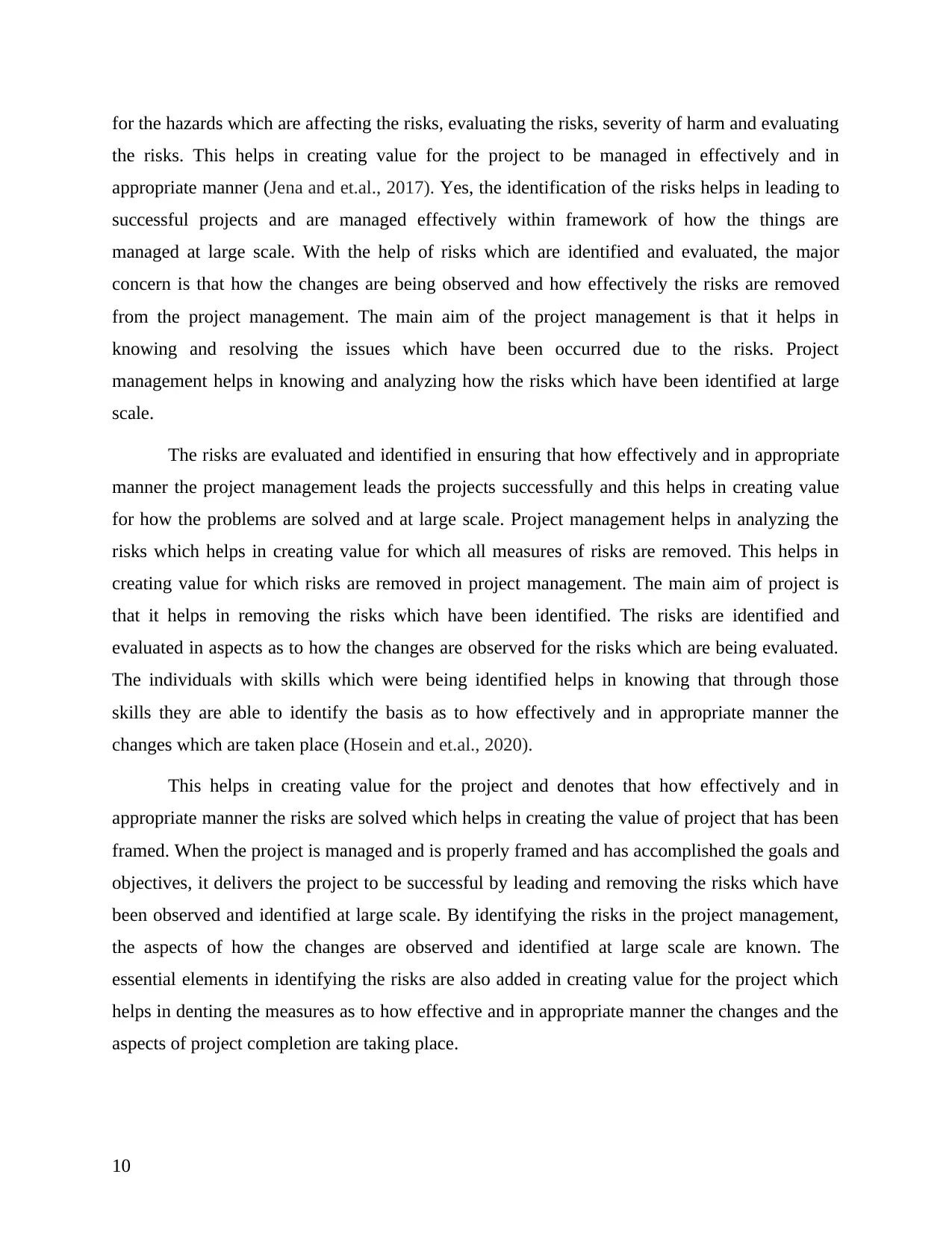
for the hazards which are affecting the risks, evaluating the risks, severity of harm and evaluating
the risks. This helps in creating value for the project to be managed in effectively and in
appropriate manner (Jena and et.al., 2017). Yes, the identification of the risks helps in leading to
successful projects and are managed effectively within framework of how the things are
managed at large scale. With the help of risks which are identified and evaluated, the major
concern is that how the changes are being observed and how effectively the risks are removed
from the project management. The main aim of the project management is that it helps in
knowing and resolving the issues which have been occurred due to the risks. Project
management helps in knowing and analyzing how the risks which have been identified at large
scale.
The risks are evaluated and identified in ensuring that how effectively and in appropriate
manner the project management leads the projects successfully and this helps in creating value
for how the problems are solved and at large scale. Project management helps in analyzing the
risks which helps in creating value for which all measures of risks are removed. This helps in
creating value for which risks are removed in project management. The main aim of project is
that it helps in removing the risks which have been identified. The risks are identified and
evaluated in aspects as to how the changes are observed for the risks which are being evaluated.
The individuals with skills which were being identified helps in knowing that through those
skills they are able to identify the basis as to how effectively and in appropriate manner the
changes which are taken place (Hosein and et.al., 2020).
This helps in creating value for the project and denotes that how effectively and in
appropriate manner the risks are solved which helps in creating the value of project that has been
framed. When the project is managed and is properly framed and has accomplished the goals and
objectives, it delivers the project to be successful by leading and removing the risks which have
been observed and identified at large scale. By identifying the risks in the project management,
the aspects of how the changes are observed and identified at large scale are known. The
essential elements in identifying the risks are also added in creating value for the project which
helps in denting the measures as to how effective and in appropriate manner the changes and the
aspects of project completion are taking place.
10
the risks. This helps in creating value for the project to be managed in effectively and in
appropriate manner (Jena and et.al., 2017). Yes, the identification of the risks helps in leading to
successful projects and are managed effectively within framework of how the things are
managed at large scale. With the help of risks which are identified and evaluated, the major
concern is that how the changes are being observed and how effectively the risks are removed
from the project management. The main aim of the project management is that it helps in
knowing and resolving the issues which have been occurred due to the risks. Project
management helps in knowing and analyzing how the risks which have been identified at large
scale.
The risks are evaluated and identified in ensuring that how effectively and in appropriate
manner the project management leads the projects successfully and this helps in creating value
for how the problems are solved and at large scale. Project management helps in analyzing the
risks which helps in creating value for which all measures of risks are removed. This helps in
creating value for which risks are removed in project management. The main aim of project is
that it helps in removing the risks which have been identified. The risks are identified and
evaluated in aspects as to how the changes are observed for the risks which are being evaluated.
The individuals with skills which were being identified helps in knowing that through those
skills they are able to identify the basis as to how effectively and in appropriate manner the
changes which are taken place (Hosein and et.al., 2020).
This helps in creating value for the project and denotes that how effectively and in
appropriate manner the risks are solved which helps in creating the value of project that has been
framed. When the project is managed and is properly framed and has accomplished the goals and
objectives, it delivers the project to be successful by leading and removing the risks which have
been observed and identified at large scale. By identifying the risks in the project management,
the aspects of how the changes are observed and identified at large scale are known. The
essential elements in identifying the risks are also added in creating value for the project which
helps in denting the measures as to how effective and in appropriate manner the changes and the
aspects of project completion are taking place.
10
Paraphrase This Document
Need a fresh take? Get an instant paraphrase of this document with our AI Paraphraser
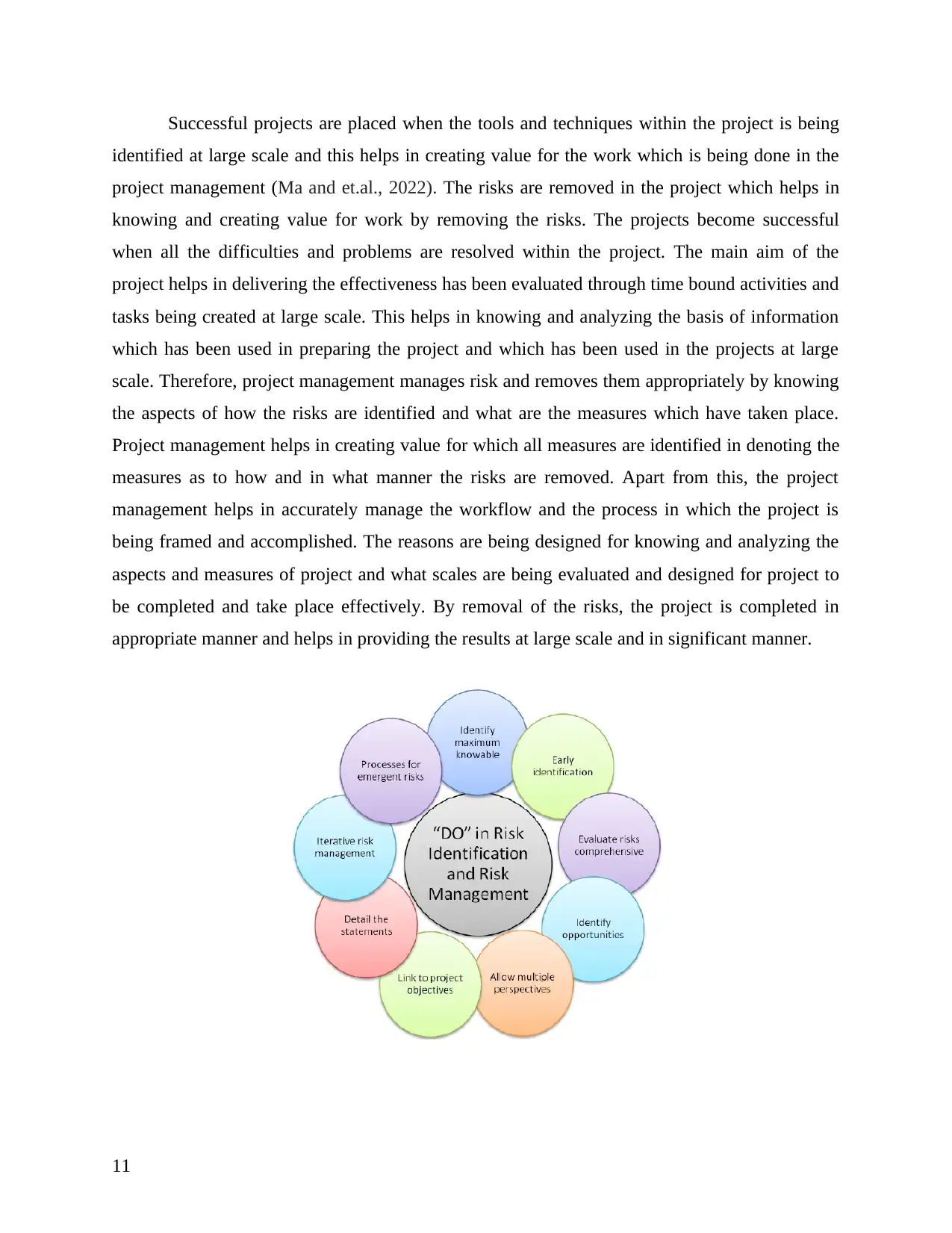
Successful projects are placed when the tools and techniques within the project is being
identified at large scale and this helps in creating value for the work which is being done in the
project management (Ma and et.al., 2022). The risks are removed in the project which helps in
knowing and creating value for work by removing the risks. The projects become successful
when all the difficulties and problems are resolved within the project. The main aim of the
project helps in delivering the effectiveness has been evaluated through time bound activities and
tasks being created at large scale. This helps in knowing and analyzing the basis of information
which has been used in preparing the project and which has been used in the projects at large
scale. Therefore, project management manages risk and removes them appropriately by knowing
the aspects of how the risks are identified and what are the measures which have taken place.
Project management helps in creating value for which all measures are identified in denoting the
measures as to how and in what manner the risks are removed. Apart from this, the project
management helps in accurately manage the workflow and the process in which the project is
being framed and accomplished. The reasons are being designed for knowing and analyzing the
aspects and measures of project and what scales are being evaluated and designed for project to
be completed and take place effectively. By removal of the risks, the project is completed in
appropriate manner and helps in providing the results at large scale and in significant manner.
11
identified at large scale and this helps in creating value for the work which is being done in the
project management (Ma and et.al., 2022). The risks are removed in the project which helps in
knowing and creating value for work by removing the risks. The projects become successful
when all the difficulties and problems are resolved within the project. The main aim of the
project helps in delivering the effectiveness has been evaluated through time bound activities and
tasks being created at large scale. This helps in knowing and analyzing the basis of information
which has been used in preparing the project and which has been used in the projects at large
scale. Therefore, project management manages risk and removes them appropriately by knowing
the aspects of how the risks are identified and what are the measures which have taken place.
Project management helps in creating value for which all measures are identified in denoting the
measures as to how and in what manner the risks are removed. Apart from this, the project
management helps in accurately manage the workflow and the process in which the project is
being framed and accomplished. The reasons are being designed for knowing and analyzing the
aspects and measures of project and what scales are being evaluated and designed for project to
be completed and take place effectively. By removal of the risks, the project is completed in
appropriate manner and helps in providing the results at large scale and in significant manner.
11
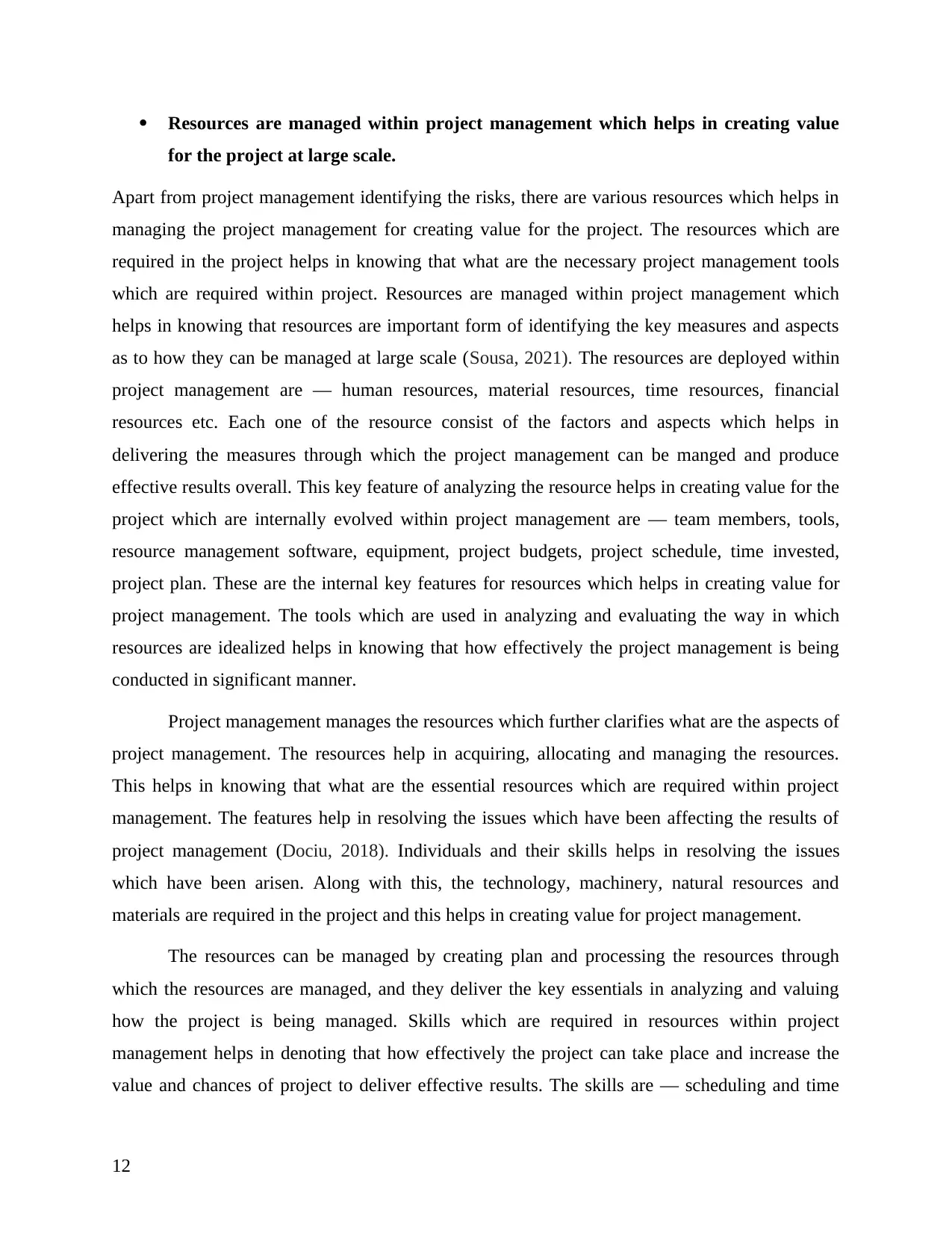
Resources are managed within project management which helps in creating value
for the project at large scale.
Apart from project management identifying the risks, there are various resources which helps in
managing the project management for creating value for the project. The resources which are
required in the project helps in knowing that what are the necessary project management tools
which are required within project. Resources are managed within project management which
helps in knowing that resources are important form of identifying the key measures and aspects
as to how they can be managed at large scale (Sousa, 2021). The resources are deployed within
project management are — human resources, material resources, time resources, financial
resources etc. Each one of the resource consist of the factors and aspects which helps in
delivering the measures through which the project management can be manged and produce
effective results overall. This key feature of analyzing the resource helps in creating value for the
project which are internally evolved within project management are — team members, tools,
resource management software, equipment, project budgets, project schedule, time invested,
project plan. These are the internal key features for resources which helps in creating value for
project management. The tools which are used in analyzing and evaluating the way in which
resources are idealized helps in knowing that how effectively the project management is being
conducted in significant manner.
Project management manages the resources which further clarifies what are the aspects of
project management. The resources help in acquiring, allocating and managing the resources.
This helps in knowing that what are the essential resources which are required within project
management. The features help in resolving the issues which have been affecting the results of
project management (Dociu, 2018). Individuals and their skills helps in resolving the issues
which have been arisen. Along with this, the technology, machinery, natural resources and
materials are required in the project and this helps in creating value for project management.
The resources can be managed by creating plan and processing the resources through
which the resources are managed, and they deliver the key essentials in analyzing and valuing
how the project is being managed. Skills which are required in resources within project
management helps in denoting that how effectively the project can take place and increase the
value and chances of project to deliver effective results. The skills are — scheduling and time
12
for the project at large scale.
Apart from project management identifying the risks, there are various resources which helps in
managing the project management for creating value for the project. The resources which are
required in the project helps in knowing that what are the necessary project management tools
which are required within project. Resources are managed within project management which
helps in knowing that resources are important form of identifying the key measures and aspects
as to how they can be managed at large scale (Sousa, 2021). The resources are deployed within
project management are — human resources, material resources, time resources, financial
resources etc. Each one of the resource consist of the factors and aspects which helps in
delivering the measures through which the project management can be manged and produce
effective results overall. This key feature of analyzing the resource helps in creating value for the
project which are internally evolved within project management are — team members, tools,
resource management software, equipment, project budgets, project schedule, time invested,
project plan. These are the internal key features for resources which helps in creating value for
project management. The tools which are used in analyzing and evaluating the way in which
resources are idealized helps in knowing that how effectively the project management is being
conducted in significant manner.
Project management manages the resources which further clarifies what are the aspects of
project management. The resources help in acquiring, allocating and managing the resources.
This helps in knowing that what are the essential resources which are required within project
management. The features help in resolving the issues which have been affecting the results of
project management (Dociu, 2018). Individuals and their skills helps in resolving the issues
which have been arisen. Along with this, the technology, machinery, natural resources and
materials are required in the project and this helps in creating value for project management.
The resources can be managed by creating plan and processing the resources through
which the resources are managed, and they deliver the key essentials in analyzing and valuing
how the project is being managed. Skills which are required in resources within project
management helps in denoting that how effectively the project can take place and increase the
value and chances of project to deliver effective results. The skills are — scheduling and time
12
You're viewing a preview
Unlock full access by subscribing today!
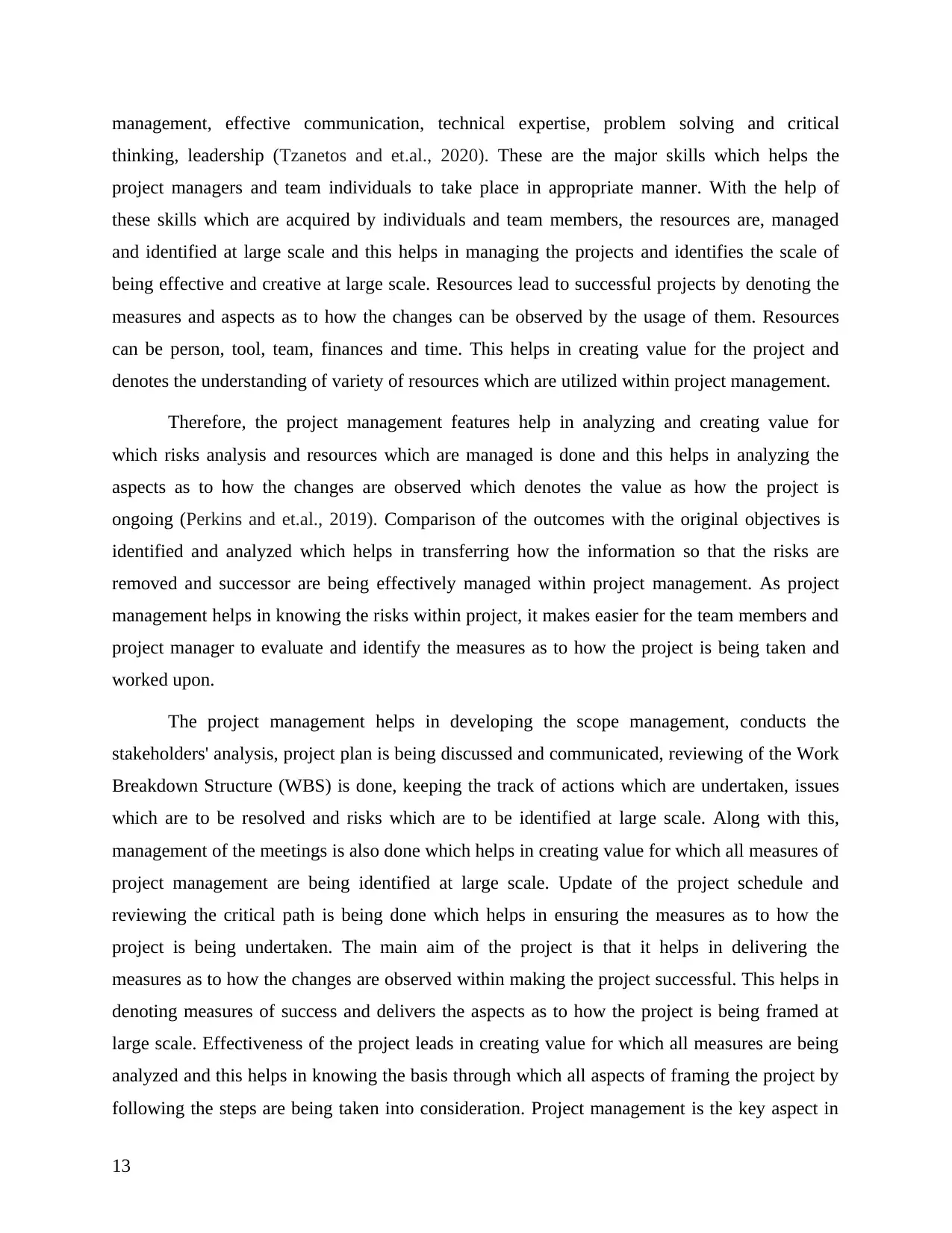
management, effective communication, technical expertise, problem solving and critical
thinking, leadership (Tzanetos and et.al., 2020). These are the major skills which helps the
project managers and team individuals to take place in appropriate manner. With the help of
these skills which are acquired by individuals and team members, the resources are, managed
and identified at large scale and this helps in managing the projects and identifies the scale of
being effective and creative at large scale. Resources lead to successful projects by denoting the
measures and aspects as to how the changes can be observed by the usage of them. Resources
can be person, tool, team, finances and time. This helps in creating value for the project and
denotes the understanding of variety of resources which are utilized within project management.
Therefore, the project management features help in analyzing and creating value for
which risks analysis and resources which are managed is done and this helps in analyzing the
aspects as to how the changes are observed which denotes the value as how the project is
ongoing (Perkins and et.al., 2019). Comparison of the outcomes with the original objectives is
identified and analyzed which helps in transferring how the information so that the risks are
removed and successor are being effectively managed within project management. As project
management helps in knowing the risks within project, it makes easier for the team members and
project manager to evaluate and identify the measures as to how the project is being taken and
worked upon.
The project management helps in developing the scope management, conducts the
stakeholders' analysis, project plan is being discussed and communicated, reviewing of the Work
Breakdown Structure (WBS) is done, keeping the track of actions which are undertaken, issues
which are to be resolved and risks which are to be identified at large scale. Along with this,
management of the meetings is also done which helps in creating value for which all measures of
project management are being identified at large scale. Update of the project schedule and
reviewing the critical path is being done which helps in ensuring the measures as to how the
project is being undertaken. The main aim of the project is that it helps in delivering the
measures as to how the changes are observed within making the project successful. This helps in
denoting measures of success and delivers the aspects as to how the project is being framed at
large scale. Effectiveness of the project leads in creating value for which all measures are being
analyzed and this helps in knowing the basis through which all aspects of framing the project by
following the steps are being taken into consideration. Project management is the key aspect in
13
thinking, leadership (Tzanetos and et.al., 2020). These are the major skills which helps the
project managers and team individuals to take place in appropriate manner. With the help of
these skills which are acquired by individuals and team members, the resources are, managed
and identified at large scale and this helps in managing the projects and identifies the scale of
being effective and creative at large scale. Resources lead to successful projects by denoting the
measures and aspects as to how the changes can be observed by the usage of them. Resources
can be person, tool, team, finances and time. This helps in creating value for the project and
denotes the understanding of variety of resources which are utilized within project management.
Therefore, the project management features help in analyzing and creating value for
which risks analysis and resources which are managed is done and this helps in analyzing the
aspects as to how the changes are observed which denotes the value as how the project is
ongoing (Perkins and et.al., 2019). Comparison of the outcomes with the original objectives is
identified and analyzed which helps in transferring how the information so that the risks are
removed and successor are being effectively managed within project management. As project
management helps in knowing the risks within project, it makes easier for the team members and
project manager to evaluate and identify the measures as to how the project is being taken and
worked upon.
The project management helps in developing the scope management, conducts the
stakeholders' analysis, project plan is being discussed and communicated, reviewing of the Work
Breakdown Structure (WBS) is done, keeping the track of actions which are undertaken, issues
which are to be resolved and risks which are to be identified at large scale. Along with this,
management of the meetings is also done which helps in creating value for which all measures of
project management are being identified at large scale. Update of the project schedule and
reviewing the critical path is being done which helps in ensuring the measures as to how the
project is being undertaken. The main aim of the project is that it helps in delivering the
measures as to how the changes are observed within making the project successful. This helps in
denoting measures of success and delivers the aspects as to how the project is being framed at
large scale. Effectiveness of the project leads in creating value for which all measures are being
analyzed and this helps in knowing the basis through which all aspects of framing the project by
following the steps are being taken into consideration. Project management is the key aspect in
13
Paraphrase This Document
Need a fresh take? Get an instant paraphrase of this document with our AI Paraphraser
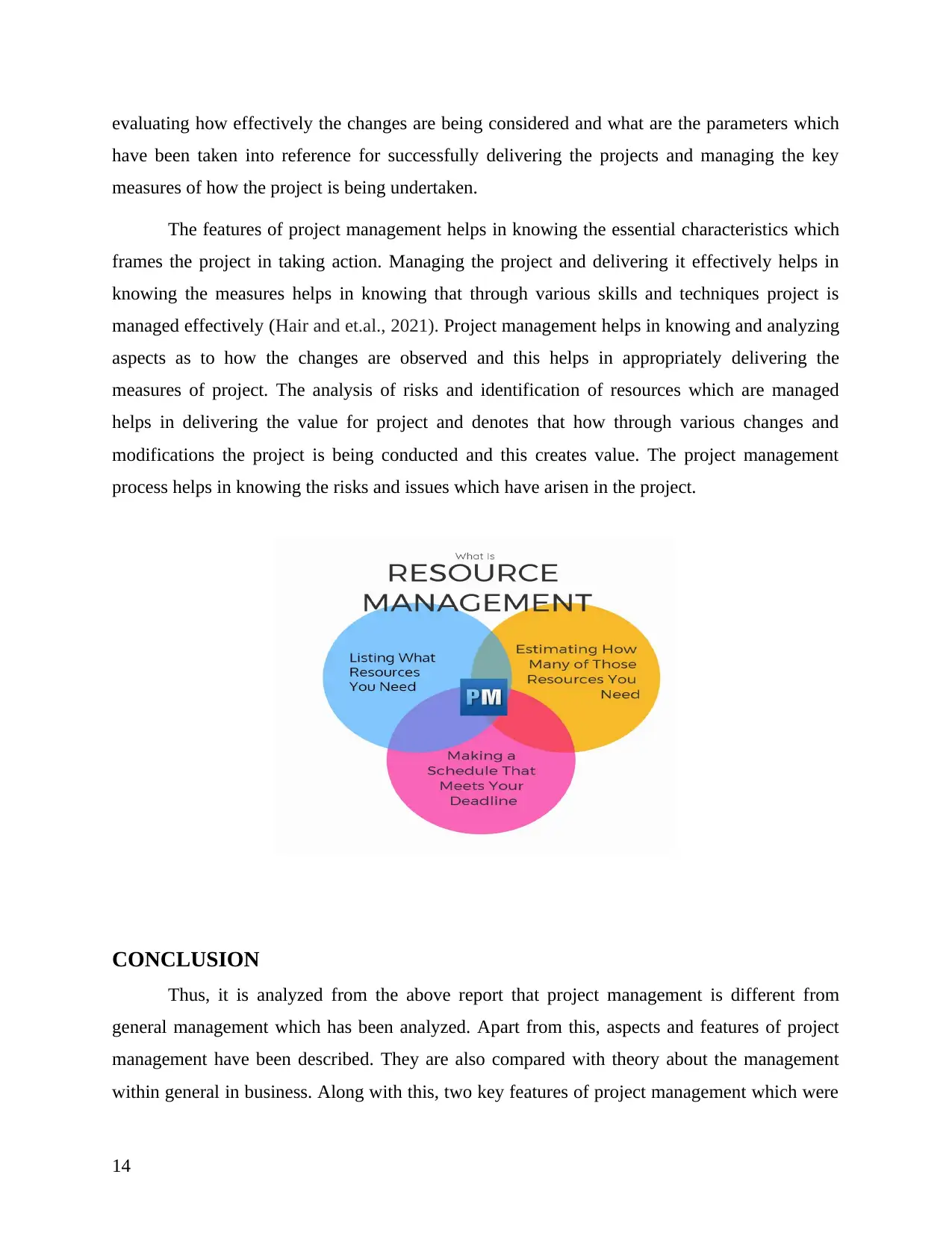
evaluating how effectively the changes are being considered and what are the parameters which
have been taken into reference for successfully delivering the projects and managing the key
measures of how the project is being undertaken.
The features of project management helps in knowing the essential characteristics which
frames the project in taking action. Managing the project and delivering it effectively helps in
knowing the measures helps in knowing that through various skills and techniques project is
managed effectively (Hair and et.al., 2021). Project management helps in knowing and analyzing
aspects as to how the changes are observed and this helps in appropriately delivering the
measures of project. The analysis of risks and identification of resources which are managed
helps in delivering the value for project and denotes that how through various changes and
modifications the project is being conducted and this creates value. The project management
process helps in knowing the risks and issues which have arisen in the project.
CONCLUSION
Thus, it is analyzed from the above report that project management is different from
general management which has been analyzed. Apart from this, aspects and features of project
management have been described. They are also compared with theory about the management
within general in business. Along with this, two key features of project management which were
14
have been taken into reference for successfully delivering the projects and managing the key
measures of how the project is being undertaken.
The features of project management helps in knowing the essential characteristics which
frames the project in taking action. Managing the project and delivering it effectively helps in
knowing the measures helps in knowing that through various skills and techniques project is
managed effectively (Hair and et.al., 2021). Project management helps in knowing and analyzing
aspects as to how the changes are observed and this helps in appropriately delivering the
measures of project. The analysis of risks and identification of resources which are managed
helps in delivering the value for project and denotes that how through various changes and
modifications the project is being conducted and this creates value. The project management
process helps in knowing the risks and issues which have arisen in the project.
CONCLUSION
Thus, it is analyzed from the above report that project management is different from
general management which has been analyzed. Apart from this, aspects and features of project
management have been described. They are also compared with theory about the management
within general in business. Along with this, two key features of project management which were
14
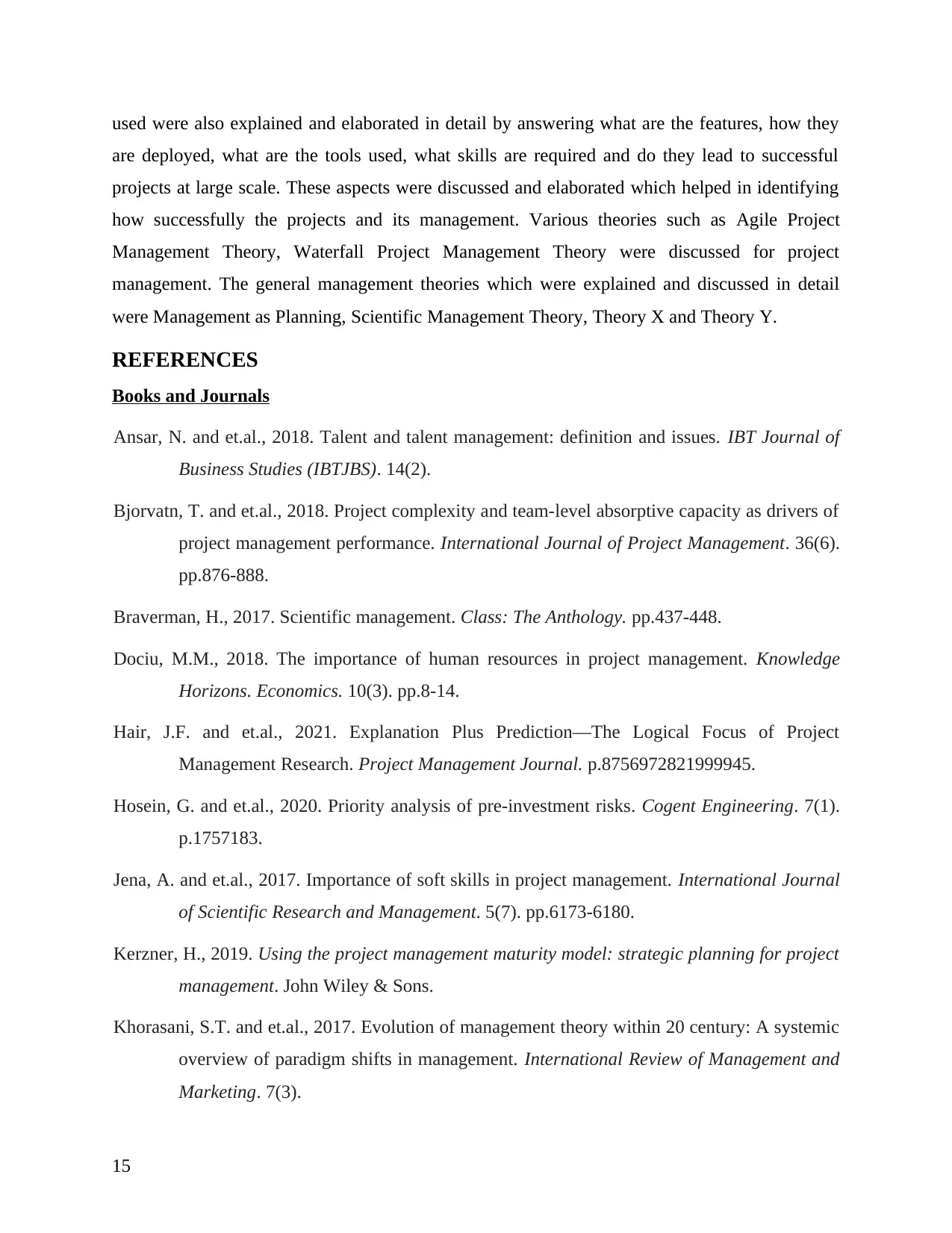
used were also explained and elaborated in detail by answering what are the features, how they
are deployed, what are the tools used, what skills are required and do they lead to successful
projects at large scale. These aspects were discussed and elaborated which helped in identifying
how successfully the projects and its management. Various theories such as Agile Project
Management Theory, Waterfall Project Management Theory were discussed for project
management. The general management theories which were explained and discussed in detail
were Management as Planning, Scientific Management Theory, Theory X and Theory Y.
REFERENCES
Books and Journals
Ansar, N. and et.al., 2018. Talent and talent management: definition and issues. IBT Journal of
Business Studies (IBTJBS). 14(2).
Bjorvatn, T. and et.al., 2018. Project complexity and team-level absorptive capacity as drivers of
project management performance. International Journal of Project Management. 36(6).
pp.876-888.
Braverman, H., 2017. Scientific management. Class: The Anthology. pp.437-448.
Dociu, M.M., 2018. The importance of human resources in project management. Knowledge
Horizons. Economics. 10(3). pp.8-14.
Hair, J.F. and et.al., 2021. Explanation Plus Prediction—The Logical Focus of Project
Management Research. Project Management Journal. p.8756972821999945.
Hosein, G. and et.al., 2020. Priority analysis of pre-investment risks. Cogent Engineering. 7(1).
p.1757183.
Jena, A. and et.al., 2017. Importance of soft skills in project management. International Journal
of Scientific Research and Management. 5(7). pp.6173-6180.
Kerzner, H., 2019. Using the project management maturity model: strategic planning for project
management. John Wiley & Sons.
Khorasani, S.T. and et.al., 2017. Evolution of management theory within 20 century: A systemic
overview of paradigm shifts in management. International Review of Management and
Marketing. 7(3).
15
are deployed, what are the tools used, what skills are required and do they lead to successful
projects at large scale. These aspects were discussed and elaborated which helped in identifying
how successfully the projects and its management. Various theories such as Agile Project
Management Theory, Waterfall Project Management Theory were discussed for project
management. The general management theories which were explained and discussed in detail
were Management as Planning, Scientific Management Theory, Theory X and Theory Y.
REFERENCES
Books and Journals
Ansar, N. and et.al., 2018. Talent and talent management: definition and issues. IBT Journal of
Business Studies (IBTJBS). 14(2).
Bjorvatn, T. and et.al., 2018. Project complexity and team-level absorptive capacity as drivers of
project management performance. International Journal of Project Management. 36(6).
pp.876-888.
Braverman, H., 2017. Scientific management. Class: The Anthology. pp.437-448.
Dociu, M.M., 2018. The importance of human resources in project management. Knowledge
Horizons. Economics. 10(3). pp.8-14.
Hair, J.F. and et.al., 2021. Explanation Plus Prediction—The Logical Focus of Project
Management Research. Project Management Journal. p.8756972821999945.
Hosein, G. and et.al., 2020. Priority analysis of pre-investment risks. Cogent Engineering. 7(1).
p.1757183.
Jena, A. and et.al., 2017. Importance of soft skills in project management. International Journal
of Scientific Research and Management. 5(7). pp.6173-6180.
Kerzner, H., 2019. Using the project management maturity model: strategic planning for project
management. John Wiley & Sons.
Khorasani, S.T. and et.al., 2017. Evolution of management theory within 20 century: A systemic
overview of paradigm shifts in management. International Review of Management and
Marketing. 7(3).
15
You're viewing a preview
Unlock full access by subscribing today!
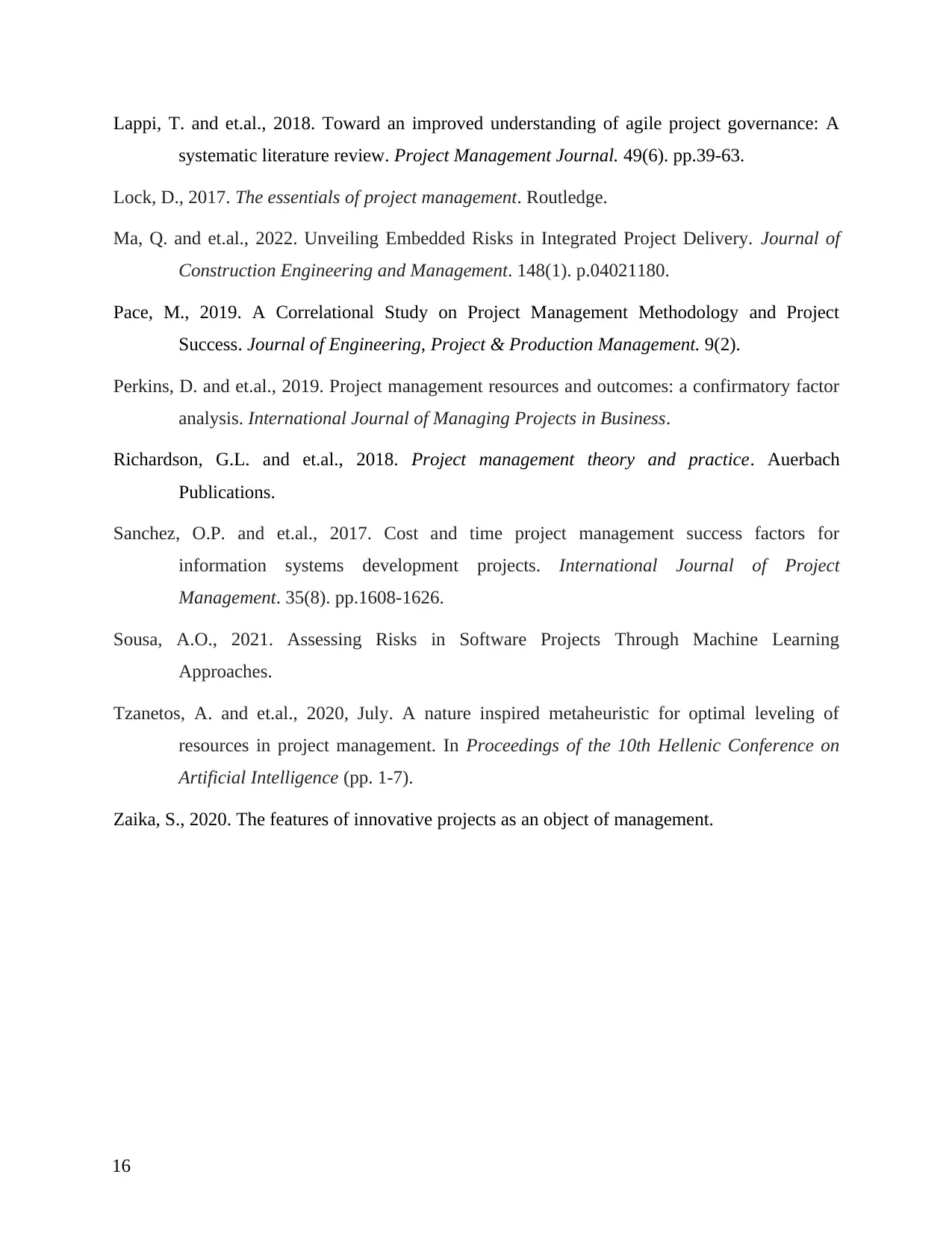
Lappi, T. and et.al., 2018. Toward an improved understanding of agile project governance: A
systematic literature review. Project Management Journal. 49(6). pp.39-63.
Lock, D., 2017. The essentials of project management. Routledge.
Ma, Q. and et.al., 2022. Unveiling Embedded Risks in Integrated Project Delivery. Journal of
Construction Engineering and Management. 148(1). p.04021180.
Pace, M., 2019. A Correlational Study on Project Management Methodology and Project
Success. Journal of Engineering, Project & Production Management. 9(2).
Perkins, D. and et.al., 2019. Project management resources and outcomes: a confirmatory factor
analysis. International Journal of Managing Projects in Business.
Richardson, G.L. and et.al., 2018. Project management theory and practice. Auerbach
Publications.
Sanchez, O.P. and et.al., 2017. Cost and time project management success factors for
information systems development projects. International Journal of Project
Management. 35(8). pp.1608-1626.
Sousa, A.O., 2021. Assessing Risks in Software Projects Through Machine Learning
Approaches.
Tzanetos, A. and et.al., 2020, July. A nature inspired metaheuristic for optimal leveling of
resources in project management. In Proceedings of the 10th Hellenic Conference on
Artificial Intelligence (pp. 1-7).
Zaika, S., 2020. The features of innovative projects as an object of management.
16
systematic literature review. Project Management Journal. 49(6). pp.39-63.
Lock, D., 2017. The essentials of project management. Routledge.
Ma, Q. and et.al., 2022. Unveiling Embedded Risks in Integrated Project Delivery. Journal of
Construction Engineering and Management. 148(1). p.04021180.
Pace, M., 2019. A Correlational Study on Project Management Methodology and Project
Success. Journal of Engineering, Project & Production Management. 9(2).
Perkins, D. and et.al., 2019. Project management resources and outcomes: a confirmatory factor
analysis. International Journal of Managing Projects in Business.
Richardson, G.L. and et.al., 2018. Project management theory and practice. Auerbach
Publications.
Sanchez, O.P. and et.al., 2017. Cost and time project management success factors for
information systems development projects. International Journal of Project
Management. 35(8). pp.1608-1626.
Sousa, A.O., 2021. Assessing Risks in Software Projects Through Machine Learning
Approaches.
Tzanetos, A. and et.al., 2020, July. A nature inspired metaheuristic for optimal leveling of
resources in project management. In Proceedings of the 10th Hellenic Conference on
Artificial Intelligence (pp. 1-7).
Zaika, S., 2020. The features of innovative projects as an object of management.
16
1 out of 16
Related Documents
Your All-in-One AI-Powered Toolkit for Academic Success.
+13062052269
info@desklib.com
Available 24*7 on WhatsApp / Email
![[object Object]](/_next/static/media/star-bottom.7253800d.svg)
Unlock your academic potential
© 2024 | Zucol Services PVT LTD | All rights reserved.




